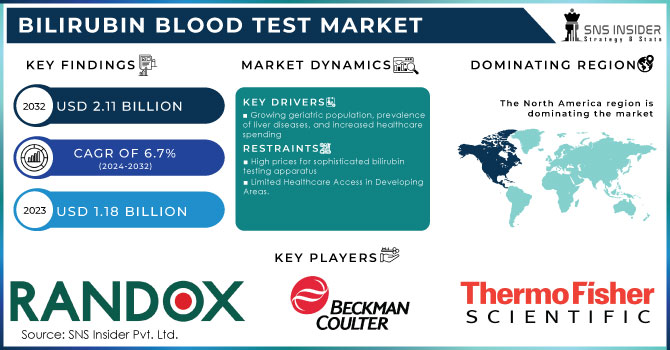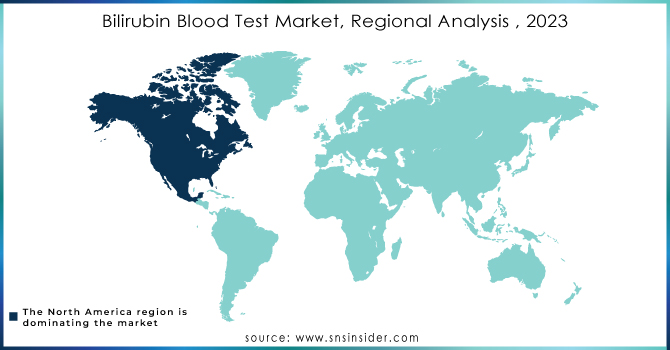Bilirubin Blood Test Market Report Scope & Overview:

Get more information on Bilirubin Blood Test Market - Request Free Sample Report
The Bilirubin Blood Test Market Size was valued at USD 1.18 billion in 2023, and is expected to reach USD 2.11 billion by 2032, and grow at a CAGR of 6.7% over the forecast period 2024-2032.
Bilirubin is a yellowish-orange pigment found in human blood. Our liver secretes this natural colour. It is expelled in bile and is created when haemoglobin breaks down. It travels via the blood to the liver, where it is stored. Through excretory organs, bilirubin is expelled from the body. High bilirubin levels are a typical problem in newborns. The skin and eyes get yellow as a result. To determine the amount of yellow bilirubin in the blood, a bilirubin blood test is performed. All of the bilirubin is eliminated from the body when the liver is working normally. When bilirubin levels are excessive, the liver is emptied of its contents, which results in illnesses like jaundice, black urine, and others.
The bile duct transports bilirubin to the liver, where it is digested. The bowels progressively discharge bilirubin. It has a brown colour because of the pigments in the faeces, which give it a yellow hue. To find out how much bilirubin is in the blood, bilirubin checks are employed. When blood bilirubin levels are higher than normal, either the body's red blood cells are degrading unusually quickly or the liver is not properly degrading waste and eliminating bilirubin from the blood. Bilirubin may degrade Heme, a material that contains iron.
MARKET DYNAMICS
DRIVERS
-
Growing geriatric population, prevalence of liver diseases, and increased healthcare spending
The market for bilirubin blood tests has been significantly impacted by the rise in liver illnesses such as cirrhosis, hepatitis, and liver cancer. Effective treatment of these disorders depends on early diagnosis and monitoring. The need for bilirubin blood tests to evaluate liver function in older people has increased since the ageing population is more susceptible to liver-related illnesses. A greater number of people are requesting routine health checks, including liver function testing, as a result of greater knowledge of liver health and rising healthcare costs.
RESTRAIN
-
High prices for sophisticated bilirubin testing apparatus
-
Limited Healthcare Access in Developing Areas.
OPPORTUNITY
-
Market Expansion for Point-of-Care Testing (POCT) and Technological Developments
The need for quick and reliable diagnostic tests is growing, which has created the potential for the creation of point-of-care bilirubin testing equipment. In distant or resource-constrained environments, POCT devices are extremely useful since they allow for quick test findings. The accuracy, effectiveness, and accessibility of bilirubin blood tests may be enhanced by developments in diagnostic technology, including biosensors and miniaturised equipment.
CHALLENGES
-
Regulatory Requirements that are Strictly Threatened by alternative diagnostic Methods Bilirubin interferes with test results.
IMPACT OF RUSSIAN UKRAINE WAR
Monetary impact for the nations participating in the conflict as well as the larger area, the war may have had considerable negative economic effects. Economic volatility can have an impact on healthcare spending, which could result in financial restrictions for medical services and diagnostic procedures. Access to Healthcare and Migration Healthcare issues for both displaced people and the host communities may result from population migration and displacement brought on by the war. In such circumstances, access to medical services, including bilirubin blood testing, may be restricted. Collaboration and International trade The war may have an effect on international trade and diplomatic ties, which may have repercussions for the import and export of medical devices and diagnostic items, reducing the accessibility of bilirubin testing technology.
IMPACT OF ONGOING RECESSION
Affordable and innovative solutions Economic downturns can also spur innovation and the pursuit of affordable solutions. To appeal to a price-conscious clientele, healthcare organisations can invest in creating more economical bilirubin testing tools or procedures. Public healthcare During recessions, spending on government healthcare programmes may be put under stress. This may result in adjustments to healthcare financing and policy, which may have an impact on the accessibility and availability of bilirubin blood tests in some areas. Recessionary periods may have an influence on financing for research and development of new medical technology, such as improvements in bilirubin testing techniques.
KEY MARKET SEGMENTS
By Test Type
-
Total Serum Bilirubin (Tsb)
-
Direct/Conjugated Bilirubin Test
-
Indirect/Unconjugated Bilirubin Test
By Product Type
-
Two Types
-
Namely
-
Consumables
-
Instruments
By Application
-
Newborn Children
-
Adults
By End-Users
-
Diagnostics Centers
-
Pathological Labs
-
Hospitals
REGIONAL COVERAGE:
North America
-
US
-
Canada
-
Mexico
Europe
-
Eastern Europe
-
Poland
-
Romania
-
Hungary
-
Turkey
-
Rest of Eastern Europe
-
-
Western Europe
-
Germany
-
France
-
UK
-
Italy
-
Spain
-
Netherlands
-
Switzerland
-
Austria
-
Rest of Western Europe
-
Asia Pacific
-
China
-
India
-
Japan
-
South Korea
-
Vietnam
-
Singapore
-
Australia
-
Rest of Asia Pacific
Middle East & Africa
-
Middle East
-
UAE
-
Egypt
-
Saudi Arabia
-
Qatar
-
Rest of Middle East
-
-
Africa
-
Nigeria
-
South Africa
-
Rest of Africa
-
Latin America
-
Brazil
-
Argentina
-
Colombia
-
Rest of Latin America
REGIONAL ANALYSES
The region that was the largest world market for bilirubin blood tests is now being eclipsed by North America, which is made up of the US and Canada. It is expected that the US will have a 4.94% CAGR in global market share.
Germany, the United Kingdom, France, Russia, and Italy collectively make up the European area, which holds the second-largest market share for bilirubin blood tests. By the end of 2027, Germany is anticipated to reach the highest value, which amounts to USD 158.8 million.

Need any customization research on Bilirubin Blood Test Market - Enquiry Now
Key Players
The major Key players are Koninklijke Philips N.V. (Noord-Holland), Beckman Coulter, Inc, Thermo Fisher Scientific Inc, Randox Laboratories Ltd, Hoffmann-La Roche AG, Dragerwerk AG & Co. KGaA, Ginevri, Advanced Instruments, Reichert, Inc, Instrumentation Laboratory, AVI Healthcare Pvt. Ltd, and other players.
RECENT DEVELOPMENTS
SN Bose National Centre: July 2020, New techniques for determining bilirubin levels in infants to check for jaundice symptoms were published by researchers at the SN Bose National Centre for Basic Sciences in India. Despite the limitations of other current bilirubin metres, the device's functioning is based on non-contact spectrometry-based approaches for measuring newborn bilirubin levels.
| Report Attributes | Details |
| Market Size by 2032 | US$ 2.11 Bn |
| CAGR | CAGR of 6.7% From 2024 to 2032 |
| Base Year | 2023 |
| Forecast Period | 2024-2032 |
| Historical Data | 2020-2022 |
| Report Scope & Coverage | Market Size, Segments Analysis, Competitive Landscape, Regional Analysis, DROC & SWOT Analysis, Forecast Outlook |
| Key Segments | • By Test Type (Total Serum Bilirubin (Tsb), Direct/Conjugated Bilirubin Test, Indirect/Unconjugated Bilirubin Test) • By Product Type (Two Types, Namely, Consumables, Instruments) • By Application (Newborn Children, Adults) • By End-Users (Diagnostics Centers, Pathological Labs, Hospitals) |
| Regional Analysis/Coverage | North America (US, Canada, Mexico), Europe (Eastern Europe [Poland, Romania, Hungary, Turkey, Rest of Eastern Europe] Western Europe] Germany, France, UK, Italy, Spain, Netherlands, Switzerland, Austria, Rest of Western Europe]). Asia Pacific (China, India, Japan, South Korea, Vietnam, Singapore, Australia, Rest of Asia Pacific), Middle East & Africa (Middle East [UAE, Egypt, Saudi Arabia, Qatar, Rest of Middle East], Africa [Nigeria, South Africa, Rest of Africa], Latin America (Brazil, Argentina, Colombia Rest of Latin America) |
| Company Profiles | Koninklijke Philips N.V. (Noord-Holland), Beckman Coulter, Inc, Thermo Fisher Scientific Inc, Randox Laboratories Ltd, Hoffmann-La Roche AG, Dragerwerk AG & Co. KGaA, Ginevri , Advanced Instruments, Reichert, Inc, Instrumentation Laboratory, AVI Healthcare Pvt. Ltd |
| Key Drivers | • Growing geriatric population, prevalence of liver diseases, and increased healthcare spending. |
| Market Restraints | • High prices for sophisticated bilirubin testing apparatus. • Limited Healthcare Access in Developing Areas. |

